
|
|
August 19, 2011
WBFO, Buffalo, NY
From time to time here on Tower Site of the Week, the fates of radio dictate that we present a "Things That Won't Be Here Much Longer" installment, and that's where we find ourselves this week. As readers of our sister column NorthEast Radio Watch know, public broadcaster WBFO (88.7) in Buffalo is nearing the end of its independent existence after more than half a century of innovative and interesting programming for western New York. Within a few months, the State University of New York will sell WBFO and its two satellite stations, WOLN (91.3 Olean) and WUBJ (88.1 Jamestown), to Buffalo's other public broadcaster, WNED, and the studios you see here will be closed down, leaving behind lots of memories (and, sadly, lots of good public radio people out of work, we fear.)
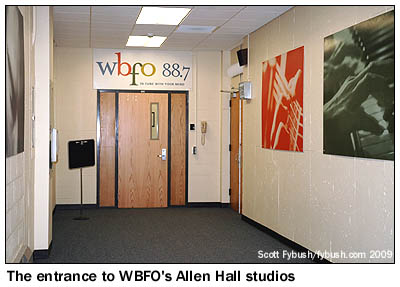 |
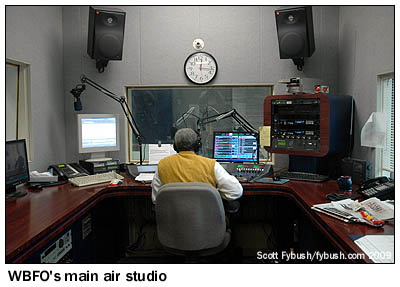 |
But for this week, at least, we look back at some better days at WBFO as we take you inside the Allen Hall studios and both the main and backup transmitter sites.
The obligatory history: WBFO started as a student-run station in 1959, when the University of Buffalo was still a private school and the campus on Main Street near the Buffalo/Amherst city line was the school's only campus. UB became part of the state university system in the mid-1960s, eventually adding a much larger new campus to the north, but WBFO never made the move to the new campus. Instead, it found itself at the forefront of what was becoming a new model of "public radio." Under the leadership of programmer Bill Siemering, WBFO in the late 1960s and early 1970s reached out to Buffalo's inner city, opening a satellite studio in the heart of the black community and devoting much of its programming day to new forms of radio journalism and storytelling.
Siemering would go on to help found National Public Radio and shape its distinctive sound, and many of his Buffalo proteges found national radio fame as well, most notably a young WBFO reporter named Terry Gross, who ended up in Philadelphia hosting "Fresh Air."
After Siemering, WBFO settled into a more standard public radio model, mixing an increasing amount of news with jazz and blues as it evolved into the professionally-run station it would become for the last three decades or so. Since the mid-1980s, WBFO's home has been on the second floor of Allen Hall, a two-story office building facing Main Street on what's now known as the "south campus," and we present here some pictures from a 2009 visit.
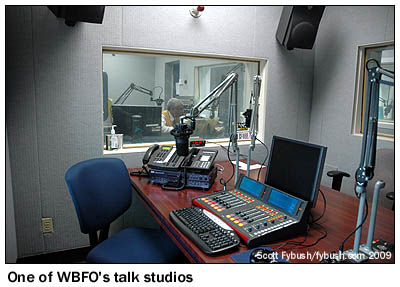 |
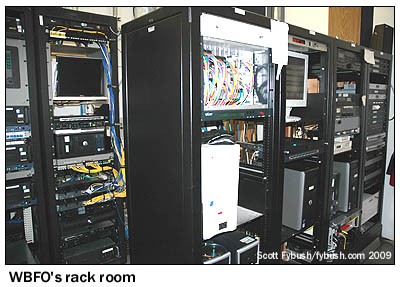 |
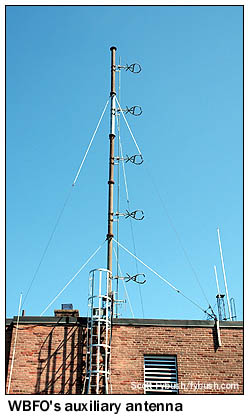
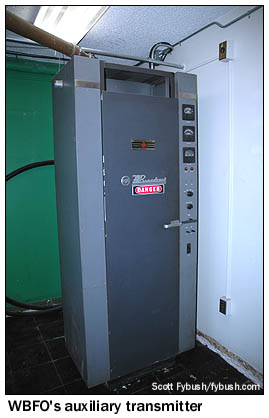 Coming
up the stairs to WBFO, we find the station's main entrance toward
the rear of the building, opening up into a newsroom area and
then into a hallway leading back past management offices to a
short row of well-soundproofed studios carpeted in gray.
Coming
up the stairs to WBFO, we find the station's main entrance toward
the rear of the building, opening up into a newsroom area and
then into a hallway leading back past management offices to a
short row of well-soundproofed studios carpeted in gray.
Two studios face the back of the building: a main air studio looking into a smaller talk/pledge drive studio. There's a third studio across the hall that can also be used for talk or production; all are equipped with Logitech consoles.
Emerging from the studio hallway, there's a small rack room and a larger record library. The rest of WBFO's offices - underwriting sales and a few more news offices - are somewhat separate, along the front of the building. And in the middle, there's a large live-performance space that's wired for sound, having been used for years for the station's "On the Border" local-music series.
The offices that face the back of Allen Hall look out on the rest of the south campus, including WBFO's old transmitter site high atop Kimball Tower, a former dorm turned medical-school building (and currently undergoing a massive renovation.)
This site still gets some use as an auxiliary transmitter facility - in fact, it was on the air the morning we drove into Buffalo to take these transmitter pictures in June 2011, and it saw plenty of action a couple of years ago when WBFO was replacing its main tower, which we'll see in a moment. The WBFO auxiliary facility is about as simple as it gets: a venerable old RCA transmitter from the station's early days and a hard-wired connection across campus to the Allen Hall studios.
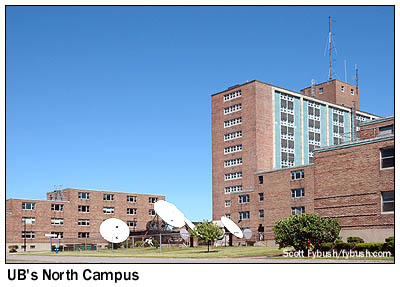
|
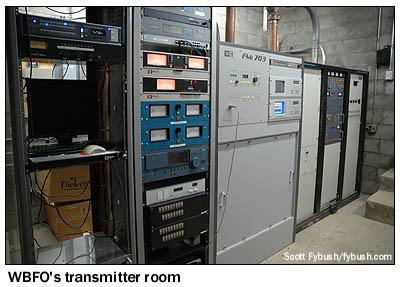 |
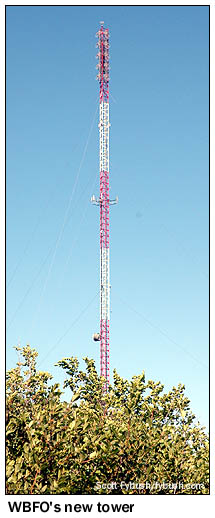
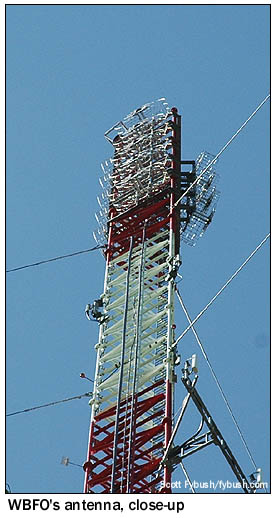 And that brings
us out to WBFO's current transmitter site, a few miles northeast
of the studios along Millersport Highway (Route 263), just across
from the newer UB North Campus.
And that brings
us out to WBFO's current transmitter site, a few miles northeast
of the studios along Millersport Highway (Route 263), just across
from the newer UB North Campus.
WBFO built out here in the 1980s, erecting an 305-foot tower at the north end of a golf course, reachable at the time only by hiking or using a golf cart.
That tower, and WBFO's upgrade at the time to 20,000 watts, was certainly an improvement over the old South Campus transmitter site - but there was still room for even more improvement, and that came in 2008 when UB replaced the old tower with a new one at the same site, this one 443 feet tall and much sturdier.
The new tower is crowned by a Dielectric directional antenna (protecting adjacent-channel signals in Rochester and Toronto), and its big 50 kW signal on 88.7 will soon be the city's only NPR news-talk voice, supplanting WNED's current (and very directional) AM 970 signal once the sale closes.
This tower is also leased out to other users: Family Life Ministries has a translator here, W243BW (96.5 Bowmansville), relaying WCOU (88.3 Warsaw), and it's expected that the new 92.1 noncommercial Amherst-licensed class A signal will come from this tower as well, once the FCC finishes sorting out which applicant (or applicants) will get it.

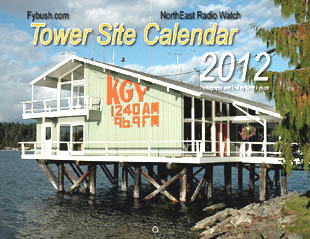 - Find out when the new Tower Site is posted,
and much more! Follow us on Twitter @NERadioWatch - and don't miss your very first chance to
order the new Tower Site Calendar 2012, coming Monday at the
Fybush.com
store!
- Find out when the new Tower Site is posted,
and much more! Follow us on Twitter @NERadioWatch - and don't miss your very first chance to
order the new Tower Site Calendar 2012, coming Monday at the
Fybush.com
store!- Previous Site of the Week: Pioneer Valley, MA
- Next Week: San Francisco, CA, 2010 (part I)
- Site of the Week INDEX!
- How can you help support Site of the Week? Click here!
- Submit your suggestions for a future Site of the Week!

